国际商务答案
- 格式:doc
- 大小:42.00 KB
- 文档页数:5
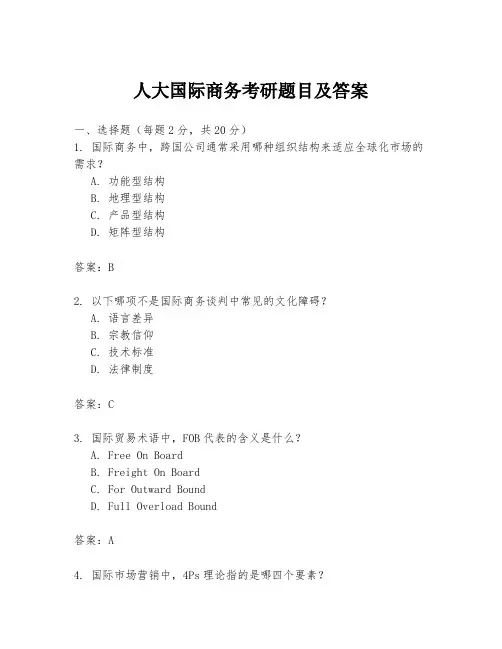
人大国际商务考研题目及答案一、选择题(每题2分,共20分)1. 国际商务中,跨国公司通常采用哪种组织结构来适应全球化市场的需求?A. 功能型结构B. 地理型结构C. 产品型结构D. 矩阵型结构答案:B2. 以下哪项不是国际商务谈判中常见的文化障碍?A. 语言差异B. 宗教信仰C. 技术标准D. 法律制度答案:C3. 国际贸易术语中,FOB代表的含义是什么?A. Free On BoardB. Freight On BoardC. For Outward BoundD. Full Overload Bound答案:A4. 国际市场营销中,4Ps理论指的是哪四个要素?A. 产品、价格、地点、促销A. 产品、价格、广告、公关B. 产品、价格、人员、促销C. 产品、价格、地点、人员答案:A5. 以下哪个不是国际商务中的风险类型?A. 政治风险B. 经济风险C. 技术风险D. 法律风险答案:C二、简答题(每题10分,共30分)1. 简述国际商务中市场调研的重要性。
答:市场调研在国际商务中至关重要,它帮助企业了解目标市场的消费者需求、市场规模、竞争对手情况以及市场趋势等关键信息。
通过市场调研,企业可以制定更有效的市场进入策略,调整产品定位,优化营销组合,从而提高国际市场竞争力和成功率。
2. 解释国际商务中的“文化适应性”概念,并举例说明。
答:文化适应性指的是企业在进入国际市场时,能够理解和适应目标市场的文化差异,并据此调整其商业行为和策略的能力。
例如,一家美国公司在进入中国市场时,可能会发现中国消费者对产品包装和广告宣传有着不同的偏好,因此需要调整其产品设计和营销策略以适应当地文化。
3. 描述国际商务中供应链管理的关键要素。
答:供应链管理的关键要素包括供应商选择、库存管理、物流协调、信息技术应用、风险管理和持续改进。
有效的供应链管理能够确保产品从原材料采购到最终用户手中的整个流程高效、成本效益高,同时降低风险和提高客户满意度。
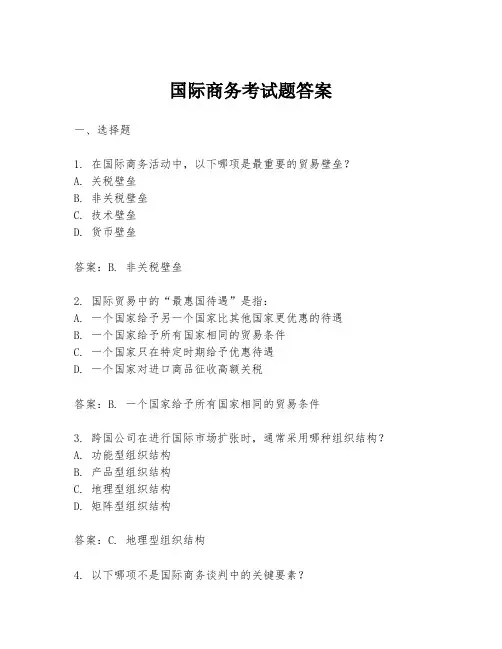
国际商务考试题答案一、选择题1. 在国际商务活动中,以下哪项是最重要的贸易壁垒?A. 关税壁垒B. 非关税壁垒C. 技术壁垒D. 货币壁垒答案:B. 非关税壁垒2. 国际贸易中的“最惠国待遇”是指:A. 一个国家给予另一个国家比其他国家更优惠的待遇B. 一个国家给予所有国家相同的贸易条件C. 一个国家只在特定时期给予优惠待遇D. 一个国家对进口商品征收高额关税答案:B. 一个国家给予所有国家相同的贸易条件3. 跨国公司在进行国际市场扩张时,通常采用哪种组织结构?A. 功能型组织结构B. 产品型组织结构C. 地理型组织结构D. 矩阵型组织结构答案:C. 地理型组织结构4. 以下哪项不是国际商务谈判中的关键要素?A. 文化差异B. 语言沟通C. 法律法规D. 产品质量答案:D. 产品质量5. 国际商务中的风险管理主要包括哪些方面?A. 市场风险B. 信用风险C. 操作风险D. 所有以上选项答案:D. 所有以上选项二、简答题1. 请简述国际商务中文化差异的影响及其应对策略。
文化差异在国际商务中可能导致沟通障碍、管理困难和市场误解等问题。
应对策略包括:增强文化意识,通过培训和教育提高对不同文化的理解和尊重;采用灵活的沟通方式,避免直译和文化刻板印象;在谈判和合同制定中考虑到文化因素,确保双方的共同理解和利益;以及建立多元化的团队,利用不同文化背景的员工的知识和经验。
2. 描述国际商务中的货币兑换风险及其管理方法。
货币兑换风险是指由于汇率波动导致的国际交易成本和收益的不确定性。
管理方法包括:使用远期合约锁定汇率,减少未来汇率变动的影响;通过多元化货币结构,分散汇率风险;采用货币期权策略,为汇率变动提供保险;以及进行内部对冲,通过内部交易来平衡不同货币的现金流。
3. 阐述国际商务中知识产权保护的重要性及其实施策略。
知识产权保护在国际商务中至关重要,因为它可以保护企业的创新成果和技术优势,防止侵权和不公平竞争。
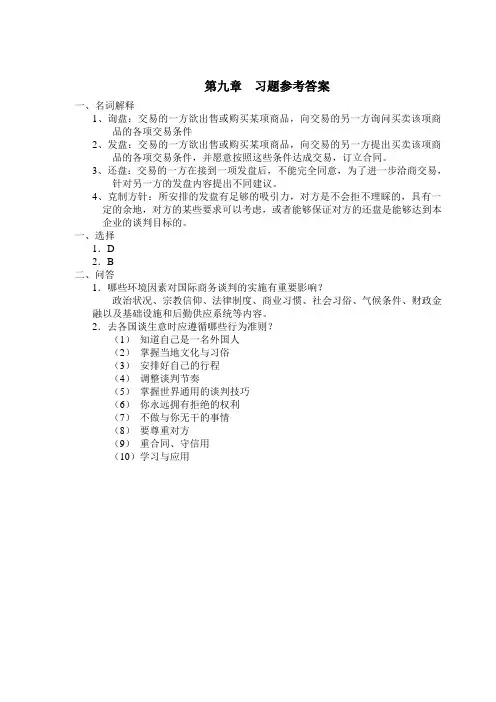
第九章习题参考答案
一、名词解释
1、询盘:交易的一方欲出售或购买某项商品,向交易的另一方询问买卖该项商
品的各项交易条件
2、发盘:交易的一方欲出售或购买某项商品,向交易的另一方提出买卖该项商
品的各项交易条件,并愿意按照这些条件达成交易,订立合同。
3、还盘:交易的一方在接到一项发盘后,不能完全同意,为了进一步洽商交易,
针对另一方的发盘内容提出不同建议。
4、克制方针:所安排的发盘有足够的吸引力,对方是不会拒不理睬的,具有一
定的余地,对方的某些要求可以考虑,或者能够保证对方的还盘是能够达到本企业的谈判目标的。
一、选择
1.D
2.B
二、问答
1.哪些环境因素对国际商务谈判的实施有重要影响?
政治状况、宗教信仰、法律制度、商业习惯、社会习俗、气候条件、财政金融以及基础设施和后勤供应系统等内容。
2.去各国谈生意时应遵循哪些行为准则?
(1)知道自己是一名外国人
(2)掌握当地文化与习俗
(3)安排好自己的行程
(4)调整谈判节奏
(5)掌握世界通用的谈判技巧
(6)你永远拥有拒绝的权利
(7)不做与你无干的事情
(8)要尊重对方
(9)重合同、守信用
(10)学习与应用。
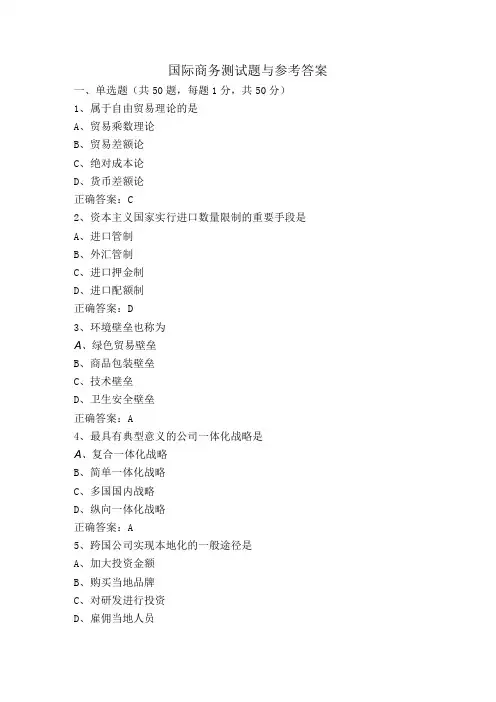
国际商务测试题与参考答案一、单选题(共50题,每题1分,共50分)1、属于自由贸易理论的是A、贸易乘数理论B、贸易差额论C、绝对成本论D、货币差额论正确答案:C2、资本主义国家实行进口数量限制的重要手段是A、进口管制B、外汇管制C、进口押金制D、进口配额制正确答案:D3、环境壁垒也称为A、绿色贸易壁垒B、商品包装壁垒C、技术壁垒D、卫生安全壁垒正确答案:A4、最具有典型意义的公司一体化战略是A、复合一体化战略B、简单一体化战略C、多国国内战略D、纵向一体化战略正确答案:A5、跨国公司实现本地化的一般途径是A、加大投资金额B、购买当地品牌C、对研发进行投资D、雇佣当地人员正确答案:C6、杠杆收购于20世纪60年代出现于A、美国B、日本C、英国D、法国正确答案:A7、国际商务谈判中谈判双方互相了解和收集情报的阶段是A、分析阶段B、策划阶段C、讨论阶段D、实施阶段正确答案:A8、投资动因是降低产品成本、追求竞争优势和更多的利润,这种跨国直接投资导向是A、低成本导向型B、先进技术导向型C、市场导向型D、自然资源导向型正确答案:A9、独家许可、从属许可和混合许可都属于A、独占许可B、中性许可C、普通许可D、交叉许可正确答案:B10、国际商务合作双方实质性接触的开始是A^还盘B、发盘C、签约D、询盘正确答案:D11、跨国公司转移利润的主要表现是A、转移产品B、调节价格C、转移成本D、合理避税正确答案:D12、现代的租赁贸易起源于A、法国B、美国C、日本D、英国正确答案:B13、在历史上第一次从生产领域出发,说明国际贸易发生与发展必然性的理论是A、绝对成本论B、比较成本论C、重商主义D、要素禀赋说正确答案:A14、世界贸易组织成员如有争端,应先行协商,在一方提出要求后必须开始协商的时限为A、60B、120C、90D、30正确答案:D15、商品生产国与商品消费国通过第三国进行的贸易,对第三国而言是A、过境贸易B、转口贸易C、直接贸易Ds多边贸易正确答案:B16、目前对跨国公司及直接投资影响最大的一种理论是A、垄断优势理论B、国际生产折衷理论C、竞争优势理论D、产品周期理论正确答案:B17、在国际商务谈判中,接受和发盘一样A、只属于法律行为B、只属于商业行为C、只属于交易行为D、既属于商业行为,也属于法律行为正确答案:D18、将取之于对外贸易中的货币仅作为财富珍藏下来,而不再投入对外贸易流通的理论称之为A、贸易平衡论B、贸易差额论C、贸易乘数理论D、货币差额论正确答案:D19、对于实行商品倾销的进口商品所征收的进口附加税是A、反倾销税B、差价税C、特惠税D、反补贴税正确答案:A20、普惠制的主要原则不包括A、特殊的B、非互惠的C、普遍的D、非歧视的正确答案:A21、我国海关正式采用《商品名称及编码协调制度》(HS)的时间是A、1996B、1992C、1994D、1993正确答案:B22、仅适用于海运和内河运输的国际贸易术语是A、FOB、FCC、CPTD、CIP正确答案:A23、在第一次世界大战与第二次世界大战之间盛行的贸易保护政策是A、早期重商主义B、新贸易保护主义C、晚期重商主义D、超保护贸易主义正确答案:D24、大卫•李嘉图的代表作是A、《国富论》B、《英国得自对外贸易的财富》C、《政治经济学及赋税原理》D、《就业、利息和货币通论》正确答案:C25、一国政府在一定时期以内,对某些商品的进口数量或金额加以直接的限制称为A、“自动”出口限制B、进口许可证制C、进口配额制D、进口押金制正确答案:C26、征税引起的进口量的变化称为A、消费效应B、生产效应C、贸易效应D、财政产应正确答案:C27、当今世界最大的服务贸易国是A^英国B、法国C、日本D、美国正确答案:D28、在租赁贸易中,连接货物的生产者和使用者的纽带是A、供货人B、出资人C、出租人D>承租人正确答案:C29、世界各国(地区)之间货物和服务交换的活动称为A、出口贸易B、进出口贸易C、进口贸易D、国际贸易正确答案:D30、凯恩斯的代表作是A、《政治经济学及赋税原理》B、《国富论》C、《就业、利息和货币通论》D、《政治经济学的国民体系》正确答案:C31、属于国际投资硬环境因素的是A^劳工素质B、管理水平C、社会文化D、自然资源正确答案:D32、货物的有关保险手续应当由卖方负责办理的国际贸易术语是B、FOC、CID、CPT正确答案:C33、一般代理又称A、佣金代理B、协议代理C、合同代理D、独家代理正确答案:A34、国际服务活动中最主要的方式是A、过境交付B、境外消费C、自然人流动D、商业存在正确答案:D35、1974年美国在其贸易法第301条款中首次使用的概念是A、世界贸易组织B、世界服务贸易C^跨国公司D、经济全球化正确答案:B36、为证明增加新投资对就业和国民收入的好处,凯恩斯提出了A、投资乘数理论B、偏好相似理论C、比较成本理论D、绝对成本理论正确答案:A37、世界贸易组织建立的时间是A、2001C、1993D、1991正确答案:B38、企业并购属于跨国直接投资的A、股权安排方式B、非股权安排方式C、BOTD、TOT正确答案:A39、产品周期理论的首创者是A、波特B、海默C、邓宁D、维农正确答案:D40、在19世纪初就被广泛采用的贸易术语是A、FOB、CFRC、CID、FCA正确答案:A41、推动经济全球化的主体是Λ^跨国公司B、国际货币基金组织C、世界银行D、世界贸易组织正确答案:A42、跨国生产本地化不包括A、人员本地化B、利润本地化C、管理本地化D、生产本地化正确答案:A43、跨国公司实现规模经济、提高全球生产效率的最基本条件是A、对员工进行东道国语言培训B、使员工适应东道国的文化C、产品及其生产过程的标准化D、给予员工有竞争力的报酬正确答案:C44、国际投资环境的特点不包括A、综合性B、动态性C、系统性D、安全性正确答案:D45、资本主义早期的国际贸易理论是A、重商主义B、凯恩斯主义C、重农主义D、超保护贸易主义正确答案:A46、普通许可又称A、交叉许可B、一般许可C、中性许可D、从属许可正确答案:B47、关税按照其保护的程度和有效性分类可分为A、财政关税和保护关税B、名义关税和有效关税C、进口附加税、差价税和特惠税D、进口税、出口税和过境税正确答案:B48、最先采用投资环境分析法的美国经济学家是A、伊西•利特瓦克B、彼得•拜廷C、罗伯特•斯托鲍夫D、威德尔希姆•保罗正确答案:C49、从世界经济相互联接的紧密性上说,世界经济一体化发展中最深刻的表现形式是A、跨国公司B、世界银行C、关贸总协定D、国际货币基金组织正确答案:A50、收购公司并不向目标公司直接提出购并的要求,而是通过在市场上收购目标公司已发行和流通的具有表决权的普通股票,从而取得目标公司控制权的行为称为A、协议收购B、友好接管C、直接并购D、间接并购正确答案:D二、多选题(共50题,每题1分,共50分)k IS014000系列标准是一套一体化的国际标准,包括A、环境标志B、环境绩效评价C、环境管理体系D、产品生命周期评价E、环境审核正确答案:ABCDE2、属于贸易保护理论的有A、贸易乘数理论B、货币差额论C、贸易差额论D、绝对成本论E、比较成本论正确答案:ABC3、属于直接非关税壁垒的有A、“自动”出口限制B、最低限价制C、进口许可证制D、进口配额制E、进口押金制正确答案:ACD4、补偿贸易的做法有A、直接产品补偿法B、技术补偿法C、劳务补偿法D、加工补偿法E、间接产品补偿法正确答案:ACE5、反倾销法限制的倾销有A、产品倾销B、运费倾销C、服务倾销D、社会倾销E、间接倾销正确答案:ADE6、跨国公司一体化战略的类型有A、复合一体化战略B、简单一体化战略C、多国国内战略D、纵向一体化战略E、横向一体化战略正确答案:ABC7、自由贸易理论的代表人物有A、俄林B、大卫・李嘉图C、赫克歇尔D、托马斯•孟E、亚当•斯密正确答案:ABCE8、适用于各种运输方式的国际贸易术语有A、CIPB、CFRC、CID、FCE、CPT正确答案:ADE9、属于间接非关税壁垒的有A、进口许可证制B、最低限价制C、海关估价制D、“自动”出口限制E、进口押金制正确答案:BCE10、商品采购中的招标投标业务的基本步骤有A、履行和约B、签订合约C、招标D、投标E、开标和评标正确答案:BCDE11、影响跨国公司经营的各种文化要素有A、行为方式与习惯B、宗教C、审美D、教育E、语言正确答案:ABCDE12、国际服务贸易的表现形式主要有A、商业存在B、境外消费C、境内消费D、过境交付E、自然人流动正确答案:ABDE13、国际商务谈判人员应具备的业务素质有A、精通外语B、心理素质C、市场经验D、有驻外经历E、专业知识正确答案:BCE14、撰写可行性研究报告需要较规范的内容,主要包括A、产业政策B、定价策略C^需求分析D、市场进入方案E、市场分析正确答案:ABCDE15、属于国际投资硬环境因素的有A、劳工素质B、能源供应C、基础设施D、政治稳定性E、自然资源正确答案:BCE16、国际生产折衷理论提出的决定一国企业对外直接投资的变量有A、所有权优势B、内部化优势C、区位优势D、技术优势E、资金优势正确答案:ABC17、跨国公司转移利润的主要表现有A、调节价格B、利润调节C、转移成本D、合理避税E、转移资金正确答案:BDE18、在两届部长会议之间,负责处理世界贸易组织日常工作的有A、总理事会B、贸易政策审议机构C、分理事会D、争端解决机构E、专门委员会正确答案:ABD19、目前在国际上受到跨国公司关注的人力资源管理战略主要有A、东道国语言培训B、适应东道国的文化C、帮助员工移民海外D、帮助员工子女在海外学习E、给予员工有竞争力的报酬正确答案:ABE20、美国麻省理工学院著名教授罗宾逊根据企业管理结构的演变及其在国外销售额增长情况,将处于不同发展阶段的企业主要分成A、出口型公司B、国际公司C、多国公司D、跨国公司E、内向型公司正确答案:ABCDE21、波特认为一个国家的内部竞争环境的形成因素有A、需求状况B、要素禀赋C、相关产业和辅助产业D、公司的策略、结构和竞争E、供给状况正确答案:ABCD22、关税的国内效应包括A、财政效应B、消费效应C、生产效应D、贸易效应E、再分配效应正确答案:ABCDE23、从收购者与被收购者的关系上来看,跨国公司对外国企业的收购可以分为A、纵向型收购B、横向型收购C、集中型收购D、混合型收购E、全部收购正确答案:ABCD24、不属于反倾销法调整范围的倾销有A、外汇倾销B、产品倾销C、运费倾销D、社会倾销E、服务倾销正确答案:ACE25、国际技术许可根据许可人和被许可人权利义务关系,可分为A、交叉许可B、中性许可C、特定许可D、独占许可E、普通许可正确答案:ABDE26、普惠制的主要原则有A、非互惠的B、非歧视的C、普遍的D、互惠的E、歧视的正确答案:ABC27、货物的风险在其越过船舷后由卖方转移至买方的国际贸易术语有A、FOB、CFRC、CID、FCE、CPT正确答案:ABC28、属于国际投资软环境因素的有A、自然资源B、社会文化C、劳工素质D、管理水平E、政治稳定性正确答案:BCDE29、企业并购的基本方法有A、许可证合同B、股票收购C、资产收购D、杠杆收购E、现金收购正确答案:BDE30、国际投资的环境因素有A、政治环境B、经济环境C、法律环境D、自然环境E、文化环境正确答案:ABCDE31、国际技术贸易一般是技术商品使用权的转让,主要包括A、肖像使用权B、商标使用权C、专有技术使用权D、著作使用权E、专利使用权正确答案:BCE32、中国环境保护的制度有A、限期治理B、环境影响评价C、污染集中控制D、排污许可证E、排污收费正确答案:ABCDE33、技术是一种无形资产,按变化程度可分为A、原有技术B、新技术C、落后技术D、改进技术E、先进技术正确答案:ABD34、跨国公司采取并购的方式进行投资的动机有A、地区多元化B、获取特定的技术C、产品多样化D、资金多元化E、进行生产正确答案:ABCDE35、国际货物买卖和服务贸易中的代理按委托人的授权分为A、合同代理B、协议代理C、一般代理D、总代理E、独家代理正确答案:CDE36、国际独资企业的形式主要有A、国外避税地公司Bs国外子公司C、国外合资公司D、国外公司集团E、国外分公司正确答案:ABE37、关税税收筹划的方法通常有A、利用保税制度B、利用税法漏洞C、利用纳税时间D、利用优惠政策E、利用完税价格正确答案:ACDE38、关税按照征税的一般方法或征税标准分类可分为A、从量税B、附加税C、选择税D、从价税E、混合税正确答案:ACDE39、技术是一种无形资产,按先进程度可分为A、原有技术B、中间技术C、新技术D、先进技术E、落后技术正确答案:BDE40、世贸组织总理事会下设的分理事会有A、与贸易有关的知识产权理事会B、技术贸易理事会C、服务贸易理事会D、国际投资理事会E、货物贸易理事会正确答案:ACE41、中国环境保护的政策有A、污染集中控制B、排污收费C、预防为主D、谁污染谁治理E、强化管理正确答案:CDE42、古典自由贸易理论有A、货币差额论B、要素禀赋说C、比较成本论D、贸易差额论E、绝对成本论正确答案:CE43、许可证贸易的标的有A^工业设计B、专有技术C、商标D、商业咨询E、专利正确答案:ABCE44、撰写可行性研究报告的目的有A、给投资者决策提供依据B、为银行贷款提供依据C、为同合作者签约提供依据D、为跨国经营和防范风险提供依据E、为工程设计提供依据正确答案:ABCDE45、属于中性许可的有A、相互许可B、独家许可C、从属许可Ds混合许可E、交叉许可正确答案:BCD46、属于自然人流动的有A、出国留学B、境外投资建厂C、境外讲学D、境外务工E、国外就医正确答案:CD47、仅适用于海运和内河运输的国际贸易术语有A、FOB、CFRC、CID、FCE、CPT正确答案:ABC48、经济特区的类型有A、自由边境区B、出口加工区C、保税区D、科学工业园区E、自由港正确答案:ABCDE49、贸易保护理论的代表人物有A、博丹B、孟克列钦C、柯尔培尔D、斯塔福德E、托马斯•孟正确答案:ABCDE50、跨文化培训一般包括A、现场体验B、语言训练C、文化介绍D、敏感性训练E、环境介绍正确答案:ABCDE。
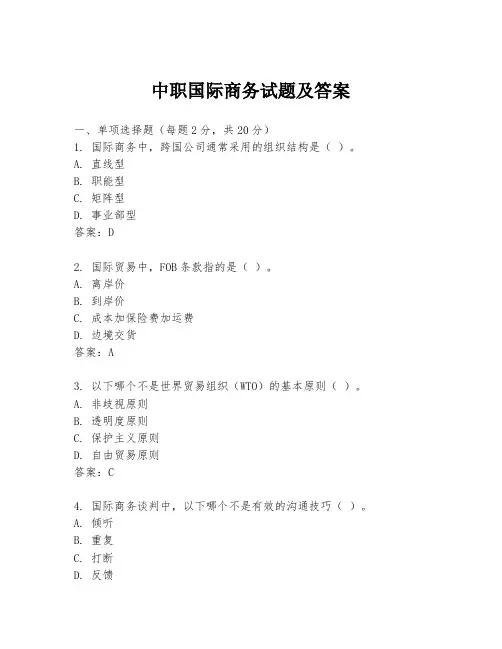
中职国际商务试题及答案一、单项选择题(每题2分,共20分)1. 国际商务中,跨国公司通常采用的组织结构是()。
A. 直线型B. 职能型C. 矩阵型D. 事业部型答案:D2. 国际贸易中,FOB条款指的是()。
A. 离岸价B. 到岸价C. 成本加保险费加运费D. 边境交货答案:A3. 以下哪个不是世界贸易组织(WTO)的基本原则()。
A. 非歧视原则B. 透明度原则C. 保护主义原则D. 自由贸易原则答案:C4. 国际商务谈判中,以下哪个不是有效的沟通技巧()。
A. 倾听B. 重复C. 打断D. 反馈答案:C5. 以下哪个不是国际商务中的风险类型()。
A. 政治风险B. 经济风险C. 文化风险D. 技术风险答案:D6. 国际商务中,以下哪个不是国际货币基金组织(IMF)的主要职能()。
A. 监督国际货币体系B. 提供技术援助C. 促进国际贸易自由化D. 提供短期贷款答案:C7. 以下哪个不是国际商务中常见的支付方式()。
A. 信用证B. 托收C. 现金交易D. 电子汇款答案:C8. 国际商务中,以下哪个不是国际商会(ICC)的主要活动()。
A. 制定国际贸易规则B. 提供仲裁服务C. 促进国际投资D. 组织国际会议答案:C9. 以下哪个不是国际商务中常见的贸易壁垒()。
A. 关税壁垒B. 配额限制C. 技术标准D. 货币贬值答案:D10. 以下哪个不是国际商务谈判中常见的策略()。
A. 让步策略B. 拖延策略C. 威胁策略D. 合作策略答案:C二、多项选择题(每题3分,共15分)1. 国际商务中,以下哪些属于国际营销的策略()。
A. 产品策略B. 价格策略C. 促销策略D. 渠道策略答案:ABCD2. 国际贸易中,以下哪些属于非关税壁垒()。
A. 进口配额B. 进口许可证C. 出口补贴D. 反倾销税答案:ABD3. 国际商务中,以下哪些属于国际商务谈判的基本原则()。
A. 互利原则B. 诚信原则C. 保密原则D. 灵活性原则答案:ABCD4. 以下哪些是国际商务中常见的风险管理方法()。
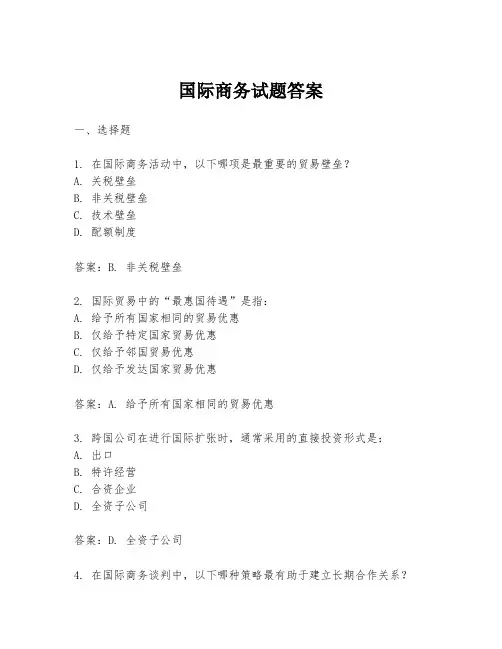
国际商务试题答案一、选择题1. 在国际商务活动中,以下哪项是最重要的贸易壁垒?A. 关税壁垒B. 非关税壁垒C. 技术壁垒D. 配额制度答案:B. 非关税壁垒2. 国际贸易中的“最惠国待遇”是指:A. 给予所有国家相同的贸易优惠B. 仅给予特定国家贸易优惠C. 仅给予邻国贸易优惠D. 仅给予发达国家贸易优惠答案:A. 给予所有国家相同的贸易优惠3. 跨国公司在进行国际扩张时,通常采用的直接投资形式是:A. 出口B. 特许经营C. 合资企业D. 全资子公司答案:D. 全资子公司4. 在国际商务谈判中,以下哪种策略最有助于建立长期合作关系?A. 强硬谈判B. 让步策略C. 合作策略D. 竞争策略答案:C. 合作策略5. 国际商务环境中,文化差异对商业活动的影响主要体现在哪些方面?A. 管理方式B. 沟通方式C. 决策过程D. 所有以上方面答案:D. 所有以上方面二、简答题1. 请简述国际商务中贸易保护主义的主要表现形式及其可能带来的影响。
答:贸易保护主义主要通过实施高关税、配额制度、技术标准和行政干预等手段来限制进口商品,保护本国产业。
这种做法可能导致国际贸易紧张关系加剧,全球贸易效率降低,最终可能引起贸易战,损害全球经济的健康发展。
2. 阐述国际商务中文化适应性的重要性及其对企业成功的作用。
答:文化适应性在国际商务中至关重要,因为它涉及到理解和尊重不同文化背景下的商业习惯和交流方式。
具备良好文化适应性能力的企业和个人能够更有效地与不同国家的合作伙伴沟通,建立信任,从而促进谈判成功、合同签订和长期合作关系的建立。
3. 描述国际商务中汇率波动对企业的影响,并提出应对策略。
答:汇率波动会影响企业的成本、定价、利润和竞争力。
企业可以通过多种策略来应对汇率风险,包括使用远期合约和期权锁定汇率、多元化货币结算、以及在不同国家间分散投资以降低单一货币波动的影响。
三、案例分析题某中国企业计划在印度建立制造工厂,以降低生产成本并更好地进入当地市场。
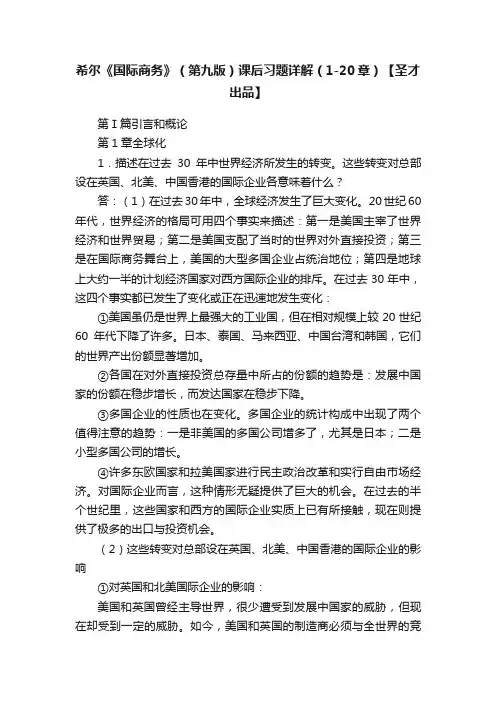
希尔《国际商务》(第九版)课后习题详解(1-20章)【圣才出品】第Ⅰ篇引言和概论第1章全球化1.描述在过去30年中世界经济所发生的转变。
这些转变对总部设在英国、北美、中国香港的国际企业各意味着什么?答:(1)在过去30年中,全球经济发生了巨大变化。
20世纪60年代,世界经济的格局可用四个事实来描述:第一是美国主宰了世界经济和世界贸易;第二是美国支配了当时的世界对外直接投资;第三是在国际商务舞台上,美国的大型多国企业占统治地位;第四是地球上大约一半的计划经济国家对西方国际企业的排斥。
在过去30年中,这四个事实都已发生了变化或正在迅速地发生变化:①美国虽仍是世界上最强大的工业国,但在相对规模上较20世纪60年代下降了许多。
日本、泰国、马来西亚、中国台湾和韩国,它们的世界产出份额显著增加。
②各国在对外直接投资总存量中所占的份额的趋势是:发展中国家的份额在稳步增长,而发达国家在稳步下降。
③多国企业的性质也在变化。
多国企业的统计构成中出现了两个值得注意的趋势:一是非美国的多国公司增多了,尤其是日本;二是小型多国公司的增长。
④许多东欧国家和拉美国家进行民主政治改革和实行自由市场经济。
对国际企业而言,这种情形无疑提供了巨大的机会。
在过去的半个世纪里,这些国家和西方的国际企业实质上已有所接触,现在则提供了极多的出口与投资机会。
(2)这些转变对总部设在英国、北美、中国香港的国际企业的影响①对英国和北美国际企业的影响:美国和英国曾经主导世界,很少遭受到发展中国家的威胁,但现在却受到一定的威胁。
如今,美国和英国的制造商必须与全世界的竞争者竞争订单,但发展中国家对其高新产品和技术的需要也能促进它们的出口份额。
此外,出于成本的考虑,英国和北美的公司可能会在成本相对低的地方设立分公司。
②对中国香港国际企业的影响:中国属于发展中国家,由之前的计划经济体制向市场经济体制转轨。
香港地理位置优越,接近日本、韩国、马来西亚和其他亚洲市场,这为出口提供了便利的条件。

国际商务复习题答案一、单项选择题1. 国际商务中,跨国公司是指在两个或两个以上国家设立分支机构或子公司的企业。
A. 正确B. 错误答案:A2. 根据国际贸易理论,比较优势理论是由哪位经济学家提出的?A. 亚当·斯密B. 大卫·李嘉图C. 约翰·梅纳德·凯恩斯D. 弗里德里希·哈耶克答案:B3. 以下哪项不是国际商务中常见的贸易壁垒?A. 关税壁垒B. 配额限制C. 出口补贴D. 技术标准答案:C二、多项选择题1. 国际商务谈判中,以下哪些因素可能影响谈判结果?A. 谈判双方的文化差异B. 谈判双方的沟通技巧C. 谈判双方的专业知识D. 谈判双方的谈判策略答案:ABCD2. 国际市场营销中,以下哪些因素属于宏观环境因素?A. 政治法律环境B. 经济环境C. 社会文化环境D. 技术环境答案:ABCD三、判断题1. 国际商务中的文化适应性是指企业能够根据不同国家的文化特点调整其经营策略和管理方式。
答案:正确2. 国际贸易中的最惠国待遇是指一个国家给予另一个国家的最优惠待遇不得低于给予任何其他国家的待遇。
答案:正确四、简答题1. 简述国际商务中市场进入模式的主要类型及其特点。
答:国际商务中市场进入模式主要包括出口、许可贸易、特许经营、合资企业、全资子公司等。
出口模式是企业将产品直接销售到国外市场,操作简单但风险较高。
许可贸易是企业授权外国企业使用其技术或品牌,收取许可费,风险较低但收益也有限。
特许经营是企业授权外国企业按照一定的标准和流程经营,可以快速扩张市场。
合资企业是与外国企业共同投资设立公司,可以共享资源和风险。
全资子公司是企业在国外设立完全控制的子公司,对市场有完全的控制权,但风险和投资也最大。
2. 描述国际商务中供应链管理的重要性。
答:国际商务中的供应链管理对于企业的成功至关重要。
它涉及到从原材料采购、产品制造、物流配送到最终销售的全过程。
有效的供应链管理可以降低成本、提高效率、增强客户满意度,并提高企业的竞争力。
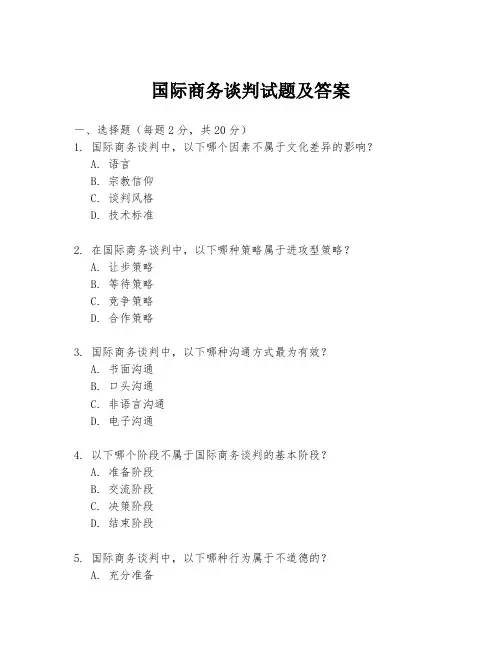
国际商务谈判试题及答案一、选择题(每题2分,共20分)1. 国际商务谈判中,以下哪个因素不属于文化差异的影响?A. 语言B. 宗教信仰C. 谈判风格D. 技术标准2. 在国际商务谈判中,以下哪种策略属于进攻型策略?A. 让步策略B. 等待策略C. 竞争策略D. 合作策略3. 国际商务谈判中,以下哪种沟通方式最为有效?A. 书面沟通B. 口头沟通C. 非语言沟通D. 电子沟通4. 以下哪个阶段不属于国际商务谈判的基本阶段?A. 准备阶段B. 交流阶段C. 决策阶段D. 结束阶段5. 国际商务谈判中,以下哪种行为属于不道德的?A. 充分准备B. 诚实守信C. 隐瞒信息D. 尊重对方6. 在国际商务谈判中,以下哪种情况最可能导致谈判失败?A. 双方需求一致B. 双方存在共同利益C. 双方互不信任D. 双方目标一致7. 国际商务谈判中,以下哪种文化因素对谈判影响最大?A. 饮食文化B. 礼仪文化C. 商业文化D. 娱乐文化8. 以下哪种谈判技巧不属于有效的谈判技巧?A. 倾听B. 观察C. 打断对方D. 反馈9. 在国际商务谈判中,以下哪种行为有助于建立良好的第一印象?A. 穿着随意B. 准时到达C. 迟到D. 忽视对方10. 国际商务谈判中,以下哪种策略是最为保守的?A. 冒险策略B. 稳健策略C. 激进策略D. 保守策略答案:1. D2. C3. B4. C5. C6. C7. C8. C9. B 10. D二、简答题(每题10分,共30分)1. 简述国际商务谈判中文化差异对谈判的影响。
答:国际商务谈判中的文化差异会对谈判过程产生显著影响。
不同的文化背景会导致谈判者在价值观、沟通方式、决策过程以及对时间的理解等方面存在差异。
这些差异可能影响谈判双方的相互理解,增加谈判的复杂性,并可能影响谈判结果。
2. 描述国际商务谈判中常见的几种谈判策略。
答:国际商务谈判中常见的谈判策略包括进攻型策略、防守型策略、合作型策略和妥协型策略。
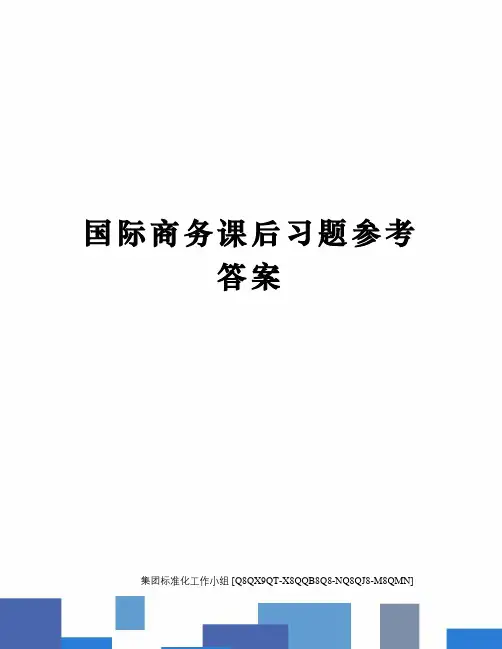
国际商务课后习题参考答案集团标准化工作小组 [Q8QX9QT-X8QQB8Q8-NQ8QJ8-M8QMN]C h a p t e r1:G l o b a l i z a t i o n1. Describe the shifts in the world economy over the last 30 years. What are the implications of these shifts for international businesses based in Great Britain North America Hong KongAnswer: The world economy has shifted dramatically over the past 30 years. As late as the 1960s, four stylized facts described the demographics of the global economy. The first was . dominancein the world economy and world trade. The second was . dominance in the world foreign direct investment picture. Related to this, the third fact was the dominance of large, multinational . firms in the international business scene. The fourth was that roughly half of the globe - the centrally planned economies of the Communist world - was off-limits to Western international businesses. All of these demographic facts have changed. Although the . remains the world's dominant economic power, its share of world output and world exports have declined significantly since the 1960s. This trend does not reflect trouble in the . economy, but rather reflects the growing industrialization of developing countries such as China, India, Indonesia, and South Korea. This trend is also reflected in the world foreign direct investment picture. As depicted in Figure in the textbook, the share of world output (or the stock of foreign direct investment) generated by developing countries has been on a steady increase since the 1960s, while the share of world output generated by rich industrial countries has been on a steady decline. Shifts in the world economy can also be seen through the shifting power of multinational enterprises. Since the 1960s, there have been two notable trends in the demographics of the multinational enterprise. The first has been the rise of . multinationals, particularly Japanese multinationals. The second has been the emergence of a growing number of small and medium-sized multinationals, called mini-multinationals. The fall of Communism in Eastern Europe and the republics of the former Soviet Union have brought about the final shift in the world economy. Many of the former Communist nations of Europe and Asia seem to share a commitment to democratic politics and free market economies. Similar developments are being observed in Latin America. If these trends continue, the opportunities for international business may be enormous. The implications of these shifts are similar for North America and Britain. The United States and Britain once had the luxury of being the dominant players in the world arena, with little substantive competition from the developing nations of the world. That has changed. Today, . and British manufacturers must compete with competitors from across the world to win orders. The changing demographics of the world economy favor a city like Hong Kong. Hong Kong (which is now under Chinese rule) is well located with easy access to markets in Japan, South Korea, Indonesia, and other Asian markets. Hong Kong has a vibrant labor force that can compete on par with the industrialized nations of the world. The decline in the influence of the . and Britain on the global economy provides opportunities for companies in Hong Kong to aggressively pursue export markets.2. "The study of international business is fine if you are going to work in a large multinational enterprise, but it has no relevance for individuals who are going to work in smaller firms." Evaluate this statement.Answer: People who believe in this view, and the firms that they work for, may find that they do not achieve their full potential (at best) and may ultimately fail because of their myopia. As barriers to trade decrease and state of the art technological developments take place throughout the world, new opportunities and threats exist on a worldwide basis. The rise of the mini-multinationals suggests there are global opportunities even for small firms. But staying attunedto international markets is not only important from the perspective of seeking profitable opportunities for small firms; it can also be critical for long-term competitive survival. Firms from other countries may be developing products that, if sold internationally, may wipe out small domestic competitors. Scanning international markets for the best suppliers is also important for small firms, for if a domestic competitor is able to tap into a superior supplier from a foreign country, it may be able to seriously erode a small firm's competitive position before the small firm understands the source of its competitor's competitive advantage and can take appropriate counter actions.3. How have changes in technology contributed to the globalization of markets and of production Would the globalization of production and markets have been possible without these technological changesAnswer: Changes in technology have contributed to the globalization of markets and of productionin a very substantive manner. For instance, improvements in transportation technology have paved the way for companies like Coca-Cola, Levi Strauss, Sony and McDonalds to make their products available worldwide. Similarly, improvements in communications technology have had a major impact. The ability to negotiate across continents has been facilitated by improved communications technology, and the rapidly decreasing cost of communications has lowered the expense of coordinating and controlling a global corporation. Finally, the impact of information technology has been far reaching. Companies can now gain worldwide exposure simply by setting up a homepage on the Internet. This technology was not available just a few short years ago. The globalization of production and markets may have been possible without improvements in technology, but the pace of globalization would have been much slower. The falling cost of technology has made it affordable for many developing nations, which has been instrumental in helping these nations improve their share of world output and world exports. The inclusion of these nations, such as China, India, Thailand, and South Korea, has been instrumental in the globalization of markets and production. In addition, improvements in global transportation and communication have made it relatively easy for business executives from different countries to converse with one another. If these forms of technology, including air-travel, fax capability, e-mail, and overnight delivery of packages were not available, it would be much more difficult for businesses to conduct international trade.4. "Ultimately, the study of international business is no different from the study of domestic business. Thus, there is no point in having a separate course on international business." Evaluate this statement.Answer: This statement reflects a poor understanding of the unique challenges involved in international business. Managing an international business is different from managing a purely domestic business for at least four reasons. These are: (1) countries are different; (2) the range of problems confronted by a manager in an international business is wider and the problems themselves more complex than those confronted by a manager in a domestic business; (3) an international business must find ways to work within the limits imposed by government intervention in the international trade and investment system; and (4) international transactions involve converting money into different currencies. As a result of these differences, there are ample reasons for studying international business as a specific field of study or discipline.5. How might the Internet and the associated World Wide Web impact international business activity and the globalization of the world economyAnswer: According to the text, the Internet and World Wide Web (WWW) promise to develop into the information background of tomorrow's global economy. This improved technology will not only makeit easier for individuals and companies in different countries to conduct business with one another, but will also further decrease the cost of communications. These improvements will undoubtedly hasten the already rapid pace of globalization. Another distinct attribute of the Internet and the WWW is that they act as an equalizer between large (resource rich) and small (resource poor) firms. For instance, it does not cost any more for a small software firm to gain visibility via the WWW than it does for a large software company like Microsoft. As a result, the WWW helps small companies reach the size of audience that was previously only within the reach of large, resource rich firms.6. If current trends continue, China may emerge as the world's largest economy by 2020. Discuss the possible implications of such a development for(1) The world trading system.(2)The world monetary system.(3)The business strategy of today's European and . based global corporations.(4)Global commodity prices.Answer: The world trading system would clearly be affected by such a development. Currently China enjoys a somewhat privileged status within the World Trade Organization as a “developing” country. Such a rise to eminence, however, would clearly force it to become a full and equal member, with all the rights and responsibilities. China would also be in a position to actively affect the terms of trade between many countries. On the monetary front, one would expect that China would have to have fully conve rtible and trading currency, and it could become one of the “benchmark” currencies of the world. From the perspective of Western global firms, China would represent botha huge market, and potentially the home base of some very capable competitors. Finally, commodity prices would probably fall.7. Read the Country Focus in this chapter on the Ecuadorian rose industry, the answer the following questions:a) How has participation in the international rose trade helped Ecuador’s economy and its people How has the rise of Ecuador as a center for rose growing benefited consumers in developed nationswho purchase the roses What do the answers to these questions tell you about the benefits of international tradeb) Why do you think that Ecuador’s rose indust ry only began to take of 20 years ago Why do you think it has grown so rapidlyc) To what extent can the alleged health problems among workers in Ecuador’s rose industry be laid at the feet of consumers in the developed world and their desire for perfect Valentine’s Day rosesd) Do you think governments in the developed world should place trade sanctions on Ecuador roses if reports of health issues among Ecuadorian rose workers are verified What else might they do to improve the situation in Ecuadora) Ecuador is the world’s fourth largest producer of roses. In fact, roses represent the country’s fifth largest export. The industry is vital to Ecuador’s economy, creating tens of thousands of jobs, jobs that pay significantly above the country’s mi nimum wage. Taxes and revenues from the rose growers have also helped to pave roads, build schools, and construct sophisticated irrigation systems. For Ecuador’s consumers, the success of the industry means bigger, more vibrant flowers than were previously available. Most students will recognize that the conditions in Ecuador give the country a distinct advantage in rose growing, and that by focusing on the industry, Ecuador has been able to benefit from international trade. Consumers in other countries also benefit from Ecuador’s flower exports with better products.b) Ecuador’s rose industry began some 20 years ago, and has been expanding rapidly ever since then. Most students will probably focus advances in technology as a key to the industry’s success. Roses are a very fragile, perishable product. Modern technology enables growers to used refrigerated air transport to get the product to markets around the globe. Without that ability, the growers would be limited to the market immediately surrounding the country.c) Students will probably be divided on this issue with some students arguing that consumers are to blame for the problems, and others placing the blame on the growers. Students taking the first perspective will probably suggest that most consumers purchase their roses with little consideration for how they are grown. Rather, most consumers simply focus on their beauty and price. Students blaming the growers might argue that growers, because they feel the effect of less-than-perfect roses in the form of smaller profits, will be motivated to find ways to produce ever more perfect flowers. Certainly, the use of pesticides and other products can produce a better crop. In the end, there is probably blame on both sides. If more consumers were aware of the health problems resulting from the improper use of pesticides, they would probably demand some changes. Similarly, if pressure were put on the growers to use pesticides safely, health problems could be reduced.d) Trade sanctions are a tool that is often employed by governments that are making a statement against a specific action or actions. In the case of Ecuador, trade sanctions certainly would be an option, as would publicizing the situation so that more consumers were aware of the conditions. In the end though, it is important to consider the effect of the sanctions or other measures on people like Maria who might lose their livelihood as a result.Chapter 2: National Differences1. Free market economies stimulate greater economic growth, whereas state-directed economies stifle growth! Discuss.Answer: In a market economy, private individuals and corporations are allowed to own property and other assets. This right of ownership provides a powerful incentive for people to work hard, introduce new products, develop better advertising campaigns, invent new products, etc., all in the hopes of accumulating additional personal capital and wealth. In turn, the constant search on the part of individuals and corporation to accumulate wealth enriches the entire economy and creates economic growth. In contrast, in a command economy, private individuals and corporations are not allowed to own substantial quantities of property and other assets. The objective of a command economy is for ever yone to work for “the good of the society.” Although this sounds like a noble ideal, a system that asks individuals to work for the good of society rather than allowing individuals to build personal wealth does not provide a great incentive for people to invent new products, develop better advertising campaigns, find ways to be more efficient, etc. As a result, command economies typically generate less innovation and are less efficient than market economies.2. A democratic political system is an essential condition for sustained economic progress. Discuss.Answer: This question has no clear-cut answer. In the West, we tend to argue that democracy is good for economic progress. This argument is largely predicted upon the idea that innovation is the engine of economic growth, and a democratic political system encourages rather than stifles innovation. However, there are examples of totalitarian regimes that have fostered a market economy and strong property rights protection and experienced rapid economic growth. The examples include four of the fastest growing economies of the past 30 years –South Korea, Taiwan, Singapore, and Hong Kong – all of which have grown faster than Western economies. However, while it is possible to argue that democracy is not a necessary precondition for the establishment of a free market economy, it seems evident that subsequent economic growth leads to establishment of democratic regimes. Several of the fastest-growing Asian economies have recently adopted more democratic governments.3. What is the relationship between corruption ., bribe taking by government officials) in a country and economic growth Is corruption always badAnswer: Economic evidence suggests that high levels of corruption significantly reduce the economic growth rate in a country. By siphoning off profits, corrupt politicians and bureaucrats reduce the returns to business investment, and hence, reduce the incentive that both domestic and foreign businesses have to invest in that country. The lower level of investment that results has a negative impact on economic growth. However, while most students will probably agree that corruption is bad, some may point out that the ., despite its Foreign Corrupt Practices Act, does allow “grease payments” to exp edite or secure the performance of a routine governmental action. According to Congress, “grease payments” while technically bribes are not being used to obtain or maintain business, but rather are simply made to facilitate performance of duties that the recipients are already obligated to perform.4. The Nobel prize-winning economist Amartya Sen argues that the concept of development should be broadened to include more than just economic development. What other factors does Sen think should be included i n an assessment of development How might adoption of Sen’s views influence government policy Do you think Sen is correct that development is about more than just economic development Explain.Answer: Sen has argued that development be assessed less by material output measures such as GNP per capita, and more by the capabilities and opportunities that people enjoy. Sen suggests that development be seen as a process of expanding real freedoms that people experience, and as such, that development requires the removal of major impediments to freedom. Governments influenced by Sen might ensure that basic health care and education programs are available especially for women. Many students will agree with Sen and the notion that development is not just an economic process, but a political one too, and that to succeed citizens must be given a voice in the important decisions made for the country.5. You are the CEO of a company that has to choose between making a $100 million investment in either Russia or the Czech Republic. Both investments promise the same long-run return, so your choice of which investment to make is driven by considerations of risk. Assess the various risks of doing business in each of these nations. Which investment would you favor and whyAnswer: When assessing the risks of investment, one should consider the political, economic, and legal risks of doing business in either Russia or the Czech Republic. At this time (Fall 2002), the risk in Russia would probably be considered higher than the risk in the Czech Republic. The Czech Republic has just been accepted as a future member of the EU, and as such gains the benefits and stability offered by the EU. Russia, by contrast, is still many years away from even being in a position to be considered by the EU for membership. Depending upon when you are using the book, this situation could be different. (You also may want to substitute other countries into this question depending on current events and the countries with which you feel your students will be most familiar.)6. Read the Country Focus on India in this chapter and answer the following questions:a. What kind of economic system did India operate during 1947-1990 What kind of system is it moving towards today What are the impediments to completing this transformationb. How might widespread public ownership of businesses and extensive government regulations have impacted (i) the efficiency of state and private businesses, and (ii) the rate of new business formation in India during the 1947-1990 time frame How do you think these factors affected the rate of economic growth in India during this time framec. How would privatization, deregulation, and the removal of barriers to foreign direct investment affect the efficiency of business, new business formation, and the rate of economic growth in India during the post-1990 time periodd. India now has pockets of strengths in key high technology industries such as software and pharmaceuticals. Why do you think India is developing strength in these areas How might success in these industries help to generate growth in other sectors of the Indian economye. Given what is now occurring in the Indian economy, do you think that the country represents an attractive target for inward investment by foreign multinationals selling consumer products Why Answer:a. The economic system that developed in India after 1947 was a mixed economy characterized by a large number of state-owned enterprises, centralized planning, and subsidies. In 1991, India’s government embarked on an ambitious economic reform program. Much of the industrial licensing system was dismantled, and several areas once closed to the private sector were opened. In addition, investment by foreign companies was welcomed, and plans to start privatizing state-owned businesses were announced. India has posted impressive gains since 1991, however there are still impediments to further transformation. Attempts to reduce import tariffs have been stalled by political opposition from employers, employees, and politicians. Moreover, the privatization program has been slowed thanks to actions taken by the Supreme Court. Finally, extreme poverty continues to plague the country.b. The mixed economy that developed in India after 1947 was characterized by a large number of state-owned enterprises, centralized planning, and subsidies. This system not only constrained the growth of the private sector, but it also consequently limited the effects of competition that typically promote efficiency and productivity in a free market system. The system even limited the actions of private companies, requiring them to get government approval for routine business activities. Production quotas and high import tariffs also stunted the development of a healthy private sector, as did restrictive labor laws that made it difficult to fire employees. Foreign exchange restrictions, limitations on foreign investment, controls on land use, and managed prices further exacerbated the situation. It would appear that India’s rate of economic growth was negatively affected during this time frame. By 1994, India’s economy was still smaller than Belgium’s despite having a large population. Bot h GDP and literacy rates were very low, and some40 percent of the population lived in poverty.c. In 1991, India’s government embarked on an ambitious economic reform program. So far, the response to the program has been impressive. The economy expanded at an annual rate of about percent from 1994 to 2004. Foreign investment is up from $150 million in 1990 to $6 billion in 2005. Certain sectors of the economy including information technology and pharmaceuticals have done particularly well. Still, problems persist. Actions taken by the government continue to limit efficiency gains for private companies and the country’s high rate of poverty is still a major problem.d. India’s gains in information technology and pharmaceuticals are impressive. The co untry has emerged as a vibrant global center for software development, and India’s pharmaceutical companies have taken a strong global position by selling low cost generic versions of drugs that have come of patent in the developed world. As these industries continue to prosper, other sectors of the economy should also see the benefit of spillover effects.e. Foreign investment is up in India. In fact, foreign investment rose from $150 million in 1990 to $6 billion in 2005. However, whether India is an attractive destination for foreign multinationals selling consumer products remains to be seen. Certainly, the large population will serve to attract some companies, but the fact that some 40 percent of the population is living in abject poverty will scare other companies away. Moreover, it is still not easy to run a company in India thanks to laws limiting everything from who can be fired to who can which products. Chapter 3: Differences in Culture1. Outline why the culture of a country influences the costs of doing business in that country. Illustrate your answer with examples.Answer: Since in a sense the entire chapter is about this question, there can be numerous reasons and examples of how culture influences the costs of doing business. Several are highlighted in the following sentences, but there could be numerous others. When there are simply different norms between how individuals from different countries interact, the costs of doing business rise as people grapple with unfamiliar ways of doing business. For example, while in the US we may get down to business first, and then get to know each other socially later, in many South American countries it is important develop a good social relationship before trying to discuss business issues. Different class structures and social mobility also raise the costs of doing business, for if there are inhibitions against working with people from different classes, then the efficiencywith which information can flow may be limited and the cost of running a business increased. A country's religion can also affect the costs of business, as religious values can affect attitudes towards work, entrepreneurship, honesty, fairness, and social responsibility. In Hindu societies where the pursuit of material well-being can be viewed as making spiritual well being less likely, worker productivity may be lower than in nations with other religious beliefs. Finally, a country's education system can have important implications for the costs of business. In countries where workers receive excellent training and are highly literate, the need for specific worker training programs are decreased and the hiring of additional employees is facilitated.2. Do you think business practices in an Islamic country are likely to differ from business practices in the United States If so, howAnswer: A number of aspects of the cultural differences between an Islamic country and the USA will cause business practices to differ. The role women can take, appropriate etiquette (including simple things like not passing papers with the left hand), holidays, and wining and dining all differ from in the USA. But beyond these, the underlying philosophy and role of business differs from in the USA. Since Muslims are stewards of property for God, rather than owners, they are more likely to use their resources carefully and may be less likely to give up or sell something to a person who may not practice the same stewardship. The importance of fairness to all parties in relations means that over-aggressiveness in self-interest may not be well received, and breaking an agreement, even if technically/legally permissible may be viewed as very inappropriate. Finally, the prohibitions on interest payments in some Islamic countries means that the wording of the terms of an agreement must be done carefully so that "fair profits" are not construed as being "interest payments."3. What are the implications for international business of differences in the dominant religion ofa countryAnswer: Differences in the dominant religion of a country affect relationships, attitudes toward business, and overall economic development. Firstly, differences in religion require inter-cultural sensitivity. This sensitivity requires things like simply knowing the religious holidays, accepting that some unexpected things may happen "because of Allah's will," or understanding how interpersonal relationships may be different between "believers" and "non-believers." (Hence non-believers may be treated differently.) Secondly, religious beliefs can significantly affect a countries attitude toward business, work, and entrepreneurship. In one country successfully beating a competitor may be considered a great achievement while in another it may be thought of as showing a lack of compassion and disruptive to the society and persons involved, both attitudes that may be derived from underlying religious beliefs. Likewise, hard work may be either rewarded positively or viewed as something of secondary importance to spiritual peace and harmony. Thirdly, different dominant religions may affect the overall competitiveness and potential for economic growth of a nation, and hence attractiveness of a country for international business.4. Choose two countries that appear to be culturally diverse. Compare the culture of thosecountries and then indicate how cultural differences influence(1)the costs of doing business in each country(2)the likely future economic development of that country(3)business practices(4)business ethicsAnswer: Responses to this question will obviously vary based on the countries chosen by the students, and their knowledge of the countries. Hopefully the student can present some information on the dimensions of culture including values, norms, social structure, religion, language, and education of the countries and also describe the key differences and similarities of the countries along these dimensions. Relating the differences between the countries along these dimensions to differences in the costs of doing business, the potential for economic development, and business practices would fully answer the question. (While it may be more difficult for students to come up with really good examples relative to business practices, the costs and prospects for economic development should be quite feasible.)Chapter 4: Ethics in International Business1. Review the Management Focus on testing drugs in the developing world and discuss the following questions:(a) Did Pfizer behave unethically by rushing to take advantage of an epidemic in Nigeria in order to test an experimental drug on sick children Should the company have proceeded more carefully (b) Is it ethical to test an experimental drug on children in emergency settings in the developing。
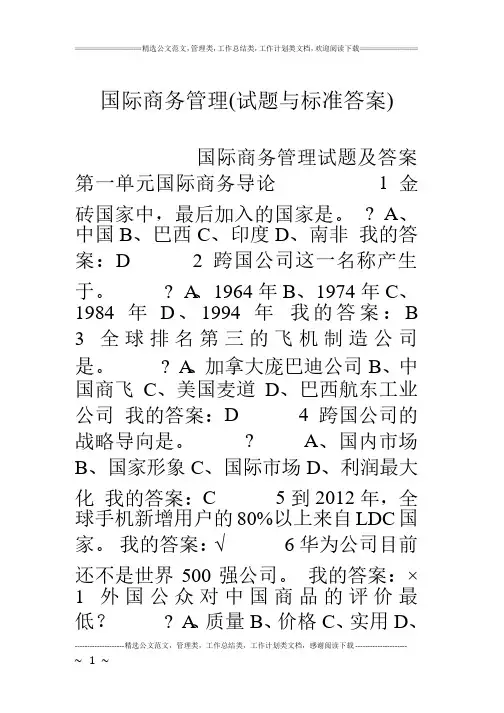
国际商务管理(试题与标准答案) 国际商务管理试题及答案第一单元国际商务导论1金砖国家中,最后加入的国家是。
? ? A A、中国B、巴西C、印度D、南非我的答案:D 2跨国公司这一名称产生于。
A、1964年B、1974年C、1984年D、1994年我的答案:B 3全球排名第三的飞机制造公司是。
? A、加拿大庞巴迪公司B、中国商飞C、美国麦道D、巴西航东工业公司我的答案:D 4跨国公司的战略导向是。
A、国内市场B、国家形象C、国际市场D、利润最大化我的答案:C 5到2012年,全球手机新增用户的80%以上来自LDC国家。
我的答案:√ 6华为公司目前还不是世界500强公司。
我的答案:×1外国公众对中国商品的评价最低? A、质量B、价格C、实用D、----------------------------------------- ----------------------------------------- 品牌和环保我的答案:D 2外国公众紧盯中国公司的方面有。
众紧盯中国公司的方面有。
? AA 、产品质量B 、售后服务C 、环保和人工权益D 、以上都有以上都有 我的答案:D 3企业国际化经营的根本性原因是。
1 ? A 、寻找新的顾客B 、寻找低成本资源C 、开发海外市场D 、打造核心竞争力 我的答案:D 4下列企业国家化经营战略中,产品对东道国当地市场的需求适应能力较差的是。
A 、本国中心战略B 、一国中心战略C 、全球中心战略D 、多国中心战略战略 我的答案:A 5在美国,下列哪种贸易形式增长最快?列哪种贸易形式增长最快? ? ? AA 、许可证贸易B 、特许经营C 、分包D 、代理代理 我的答案:C 62010年,中国对外直接投资存量实现连续9年增长。
我的答案:× 7跨国公司越大发展越好。
好。
我的答案:× 1需要较少的新兴市场,但是需要较多的跨国界价值链协调的公司称为。
国际商务大一试题答案一、选择题1. 在国际商务活动中,以下哪项不是文化差异可能带来的挑战?A. 沟通障碍B. 管理实践差异C. 货币汇率波动D. 法律法规的不一致性答案:C2. 国际贸易中最常见的支付方式是什么?A. 信用证B. 汇票C. 电汇D. 支票答案:A3. 世界贸易组织(WTO)的主要目标是什么?A. 促进国际贸易自由化B. 保障成员国的国家安全C. 限制跨国公司的活动D. 增加成员国的关税答案:A4. 在国际商务谈判中,以下哪种策略最有助于建立信任关系?A. 强硬谈判B. 让步策略C. 共赢策略D. 欺骗策略答案:C5. 多国公司的全球战略通常包括哪些方面?A. 产品标准化B. 价格策略C. 促销活动D. 所有以上选项答案:D二、简答题1. 请简述国际商务中的政治风险及其可能的影响。
答:政治风险是指在国际商务活动中,由于东道国政治环境的不稳定或政策变化而可能给企业带来的风险。
这些风险可能包括政府政策的突然改变、政治冲突或暴力事件、国有化或征收以及贸易壁垒的增加等。
政治风险可能导致企业投资损失、运营中断、市场准入困难以及利润减少等负面影响。
2. 描述文化适应性在国际商务中的重要性。
答:文化适应性在国际商务中极为重要,因为它涉及到与不同文化背景的人进行有效沟通和交流的能力。
具备文化适应性的个人或企业能够更好地理解不同文化中的商业习惯、交流风格和决策过程,从而在跨文化交流中减少误解和冲突,促进合作关系的建立和维护。
此外,文化适应性还有助于企业在国际市场中更好地定位产品和服务,满足不同消费者的需求。
3. 国际商务中的伦理问题通常包括哪些方面?答:国际商务中的伦理问题包括但不限于以下几个方面:公平交易,即确保所有商业活动都是公正和透明的;尊重人权,包括劳工权益和消费者权益;环境保护,要求企业在经营活动中考虑对环境的影响;反对腐败和贿赂,维护商业活动的诚信;以及尊重当地文化和习俗,避免文化冲突和不敏感的行为。
国际商务英语孙莹课后答案1、I’ve got some very _______ news to tell you. [单选题] *A. exciting(正确答案)B. comfortableC. convenientD. beautiful2、Our campus is _____ big that we need a bike to make it. [单选题] *A. veryB. so(正确答案)C. suchD. much3、The paper gives a detailed()of how to create human embryos (胚胎)by cloning. [单选题] *A. intentionB. description(正确答案)C. affectionD. effort4、During the Spring Festival, people in Northern China usually eat _______ as a traditional Chinese food. [单选题] *A. pizzaB. dumplings(正确答案)C. hamburgersD. noodles5、You have failed two tests. You’d better start working harder, ____ you won’t pass the course. [单选题] *A. andB. soC. butD. or(正确答案)6、The Chinese team are working hard _______ honors in the Olympic Games. [单选题] *A. to win(正确答案)B. winC. winningD. won7、Every morning John takes a()to his office. [单选题] *A. 20-minutes' walkB. 20 minute ' walkC. 20-minutes walkD. 20-minute walk(正确答案)8、Both Mary and Linda don't care for fish. [单选题] *A. 喜欢(正确答案)B. 关心C. 照料D. 在乎9、( ) --------Please take my seat here.-------- __________________________. [单选题]*A. That is nice of you(正确答案)B. I think it is my seatC. No, you sit hereD. I don’t think it’s a good seat.10、He always found it hard to satisfy himself. [单选题] *A. 控制B. 满足(正确答案)C. 了解D. 批评11、Tom will _______ me a gift from Japan. [单选题] *A. takeB. getC. carryD. bring(正确答案)12、The car _______ after forty minutes driving, so he didn’t have the interview on time. [单选题] *A. broke down(正确答案)B. broke inC. broke outD. broke up13、—Can you play tennis? —______, but I’m good at football.()[单选题] *A. Yes, I can(正确答案)B. Yes, I doC. No, I can’tD. No, I don’t14、--Is that the correct spelling?--I don’t know. You can _______ in a dictionary [单选题] *A. look up itB. look it forC. look it up(正确答案)D. look for it15、The managing director took the()for the accident, although it was not his fault. [单选题] *A. GuiltB. charge(正确答案)C. blameD. accusation16、The work will be finished _______ this month. [单选题] *A. at the endB. in the endC. by the endD. at the end of(正确答案)17、28.The question is very difficult. ______ can answer it. [单选题] *A.EveryoneB.No one(正确答案)C.SomeoneD.Anyone18、82.—Is there a bookshop near here?—Yes. Walk ________ the road for five minutes and you'll see one near a big tree. [单选题] *A.toB.along(正确答案)C.ofD.about19、Something must be wrong with the girl’s _______. She can’t hear clearly. [单选题] *A. ears(正确答案)B. noseC. armsD. eyes20、I’m still unable to make myself_____in the discussion, which worries me a lot. [单选题]*A.understandB.understood(正确答案)C.understandingD.to be understood21、I have worked all day. I'm so tired that I need _____ . [单选题] *A. a night restB. rest of nightC. a night's rest(正确答案)D. a rest of night22、You can borrow my book, _____ you promise to give it back to me by the end of this month. [单选题] *A.even ifB. as long as(正确答案)C. in caseD. even though23、He prefers to use the word “strange”to describe the way()she walks. [单选题] *A. in which(正确答案)B. by whichC. in thatD. by that24、Many of my classmates are working _______volunteers. [单选题] *A. as(正确答案)B. toC. atD. like25、Taking the subway is quite fast and cheap. It can _______ both time and money. [单选题] *A. savesB. save(正确答案)C. earnD. use26、Leave your key with a neighbor ___ you lock yourself out one day [单选题] *A. ever sinceB. even ifC. soon afterD. in case(正确答案)27、The reason why I didn't attend the lecture was simply()I got a bad cold that day. [单选题] *A. becauseB. asC. that(正确答案)D. for28、The train is coming. Be ______! [单选题] *A. careful(正确答案)B. carefullyC. carelessD. care29、Becky is having a great time ______ her aunt in Shanghai. ()[单选题] *A. to visitB. visitedC. visitsD. visiting(正确答案)30、Since we have _____ money left,we can't afford the expensive computer. [单选题] *A. a littleB. a fewC. little(正确答案)D. few。
国际商务期末考试题及答案一、选择题(每题2分,共20分)1. 国际商务是指:A. 国内贸易B. 跨国贸易C. 国际贸易D. 国际投资2. 跨国公司通常是指:A. 拥有海外子公司的公司B. 只在本国运营的公司C. 只做出口贸易的公司D. 只做进口贸易的公司3. 国际商务中,以下哪个不是文化差异的影响因素?A. 语言B. 宗教C. 教育水平D. 法律体系4. 国际商务中,以下哪个不是贸易壁垒?A. 关税B. 配额C. 反倾销税D. 国际货币基金组织(IMF)5. 以下哪个不是国际商务谈判的特点?A. 需要考虑文化差异B. 需要考虑法律法规C. 只关注价格因素D. 需要考虑政治风险6. 国际商务中,以下哪个不是风险管理的策略?A. 风险规避B. 风险转移C. 风险接受D. 风险增加7. 国际商务中,以下哪个不是市场进入策略?A. 出口B. 合资C. 独资D. 进口8. 国际商务中,以下哪个不是国际支付方式?A. 信用证B. 汇票C. 支票D. 现金交易9. 国际商务中,以下哪个不是国际物流的特点?A. 跨国性B. 复杂性C. 单一性D. 时效性10. 国际商务中,以下哪个不是国际市场营销的策略?A. 产品策略B. 价格策略C. 渠道策略D. 质量策略二、简答题(每题10分,共30分)1. 简述国际商务与国内商务的主要区别。
2. 描述国际商务谈判中文化差异对谈判的影响。
3. 解释什么是国际市场营销的4P策略。
三、案例分析题(每题25分,共50分)1. 假设你是一家跨国公司的市场部经理,公司计划进入一个新的国际市场。
请分析并提出你的市场进入策略,并解释你的选择。
2. 某国际公司在海外运营时遇到了当地政府的贸易壁垒,导致产品无法顺利进入市场。
请分析可能的解决方案,并提出你的建议。
国际商务期末考试答案一、选择题1. C2. A3. C4. D5. C6. D7. D8. D9. C10. D二、简答题1. 国际商务与国内商务的主要区别在于国际商务涉及跨国界,需要考虑不同国家的法律法规、文化差异、政治风险以及汇率变动等因素。
国际商务考研试题及答案一、单项选择题(每题2分,共20分)1. 国际商务中的“文化冲突”通常指的是什么?A. 不同国家之间的经济利益冲突B. 不同国家之间的政治立场冲突C. 不同国家之间的宗教信仰冲突D. 不同国家之间因文化差异导致的误解或矛盾答案:D2. 在国际商务中,以下哪项不是跨国公司进行市场调研时需要考虑的因素?A. 当地的法律法规B. 当地的消费者偏好C. 当地的宗教节日D. 公司的内部决策答案:D3. 国际货币基金组织(IMF)的主要职能不包括以下哪项?A. 监督全球经济和金融稳定B. 提供政策建议和技术支持C. 提供短期资金支持以帮助解决国际收支平衡问题D. 直接投资于成员国的基础设施建设答案:D4. 在国际商务谈判中,以下哪种策略不属于常见的价格谈判策略?A. 逐步让步B. 一次性报价C. 价格分割D. 情感诉求答案:D5. 以下哪个组织不属于国际贸易中的区域经济一体化组织?A. 欧盟(EU)B. 世界贸易组织(WTO)C. 北美自由贸易协定(NAFTA)D. 亚太经济合作组织(APEC)答案:B6. 跨国公司在进行国际市场扩张时,通常不会采用哪种方式?A. 直接投资B. 特许经营C. 出口D. 合资企业答案:D7. 在国际商务中,以下哪种运输方式通常不适用于易腐烂的商品?A. 航空运输B. 海运C. 铁路运输D. 公路运输答案:B8. 以下哪个因素不是影响国际商务中汇率变动的主要因素?A. 经济政策B. 利率水平C. 政治稳定性D. 企业规模答案:D9. 在国际商务中,以下哪种支付方式的风险最高?A. 信用证B. 汇付C. 托收D. 现金交易答案:C10. 以下哪个不是国际市场营销策略中的4P?A. Product(产品)B. Price(价格)C. Place(地点)D. Process(过程)答案:D二、简答题(每题10分,共30分)1. 简述国际商务中的全球化与多国化策略的区别。
国际商务自考考试题目及答案一、单项选择题(每题1分,共10分)1. 国际商务中,跨国公司通常指的是在两个或两个以上国家设立分支机构的企业。
以下哪项不是跨国公司的特点?A. 产品多样化B. 市场全球化C. 管理集中化D. 资本国际化答案:C2. 在国际市场上,企业进行市场调研时,以下哪项不是市场调研的内容?A. 消费者偏好B. 法律法规环境C. 竞争对手分析D. 企业内部财务状况答案:D3. 以下哪种贸易术语不属于国际商会(ICC)制定的国际贸易术语解释通则(Incoterms)?A. EXWB. FOBC. CIFD. CPT答案:D4. 国际商务谈判中,以下哪项不是有效的沟通策略?A. 明确目标B. 避免文化差异C. 建立信任D. 准备充分答案:B5. 以下哪种支付方式不涉及银行信用?A. 信用证B. 汇付C. 托收D. 保函答案:B6. 国际贸易中,最常用的价格术语是哪种?A. FOB(Free On Board)B. CIF(Cost, Insurance and Freight)C. DDP(Delivered Duty Paid)D. EXW(Ex Works)答案:A7. 在国际商务中,以下哪项不是影响汇率变动的因素?A. 经济政策B. 利率水平C. 黄金价格D. 政治稳定性答案:C8. 以下哪种保险类型适用于国际货物运输?A. 车辆保险B. 人寿保险C. 海运保险D. 火灾保险答案:C9. 国际商务合同中,以下哪项不是合同的基本条款?A. 价格条款B. 质量条款C. 交付时间D. 促销策略答案:D10. 国际商务中,以下哪种组织不是国际性的经济组织?A. 世界贸易组织(WTO)B. 国际货币基金组织(IMF)C. 亚太经济合作组织(APEC)D. 美国商会答案:D二、多项选择题(每题2分,共10分)11. 以下哪些因素会影响国际市场的进入策略?A. 市场规模B. 法律法规C. 文化差异D. 技术标准答案:A, B, C, D12. 在国际商务中,以下哪些属于非关税壁垒?A. 进口配额B. 出口补贴C. 技术标准D. 关税答案:A, C13. 以下哪些属于国际商务中的直接投资方式?A. 独资B. 合资C. 特许经营D. 许可经营答案:A, B14. 以下哪些是国际贸易中的风险管理策略?A. 风险规避B. 风险转移C. 风险接受D. 风险预防答案:A, B, C15. 以下哪些因素会影响国际商务谈判的结果?A. 谈判策略B. 语言能力C. 市场信息D. 谈判环境答案:A, B, C, D三、简答题(每题5分,共20分)16. 简述国际商务中文化差异对谈判的影响。
参考答案一.根据合同审证,指出不符之处并提出修改意见(共36 分)(备注备:如果写成“XXX 行错,应该改为XXXXX”,也给全分)1.31C: 开证日期比合同规定晚了半个月;(2 分)2.31D: 有效期规定为“090202”与合同规定不符;(1 分)应改为“090215”;(1 分)3.31D:到期地点“SPAIN” 与合同规定不符;(1 分)应改为“CHINA”;(1 分)4.59: 受益人名称与合同规定不符;(1 分)应改为“SHANDONG YIHAI IMP. & EXP. CO.,LTD.”;(1 分)5.32B: 货币名称与合同规定不符;(1 分)应改为“USD”;(1 分)6.42C: 汇票付款期限与合同规定不符;(1 分)应改为“AT SIGHT”;(1 分)7.42A: 汇票付款人为开证申请人不妥;(1 分)应改为“BANCO SANTANDER, S.A”;(1 分)8.43P: 不允许分批与合同规定不符;(1 分)应改为“ALLOWED”;(1 分)9.43T: 不允许转运与合同规定不符;(1 分)应改为“ALLOWED”;(1 分)10.44F: 目的港与合同规定不符;(1 分)应改为“BARCELONA”;(1 分)11.44C: 最迟装运期与合同规定不符;(1 分)应改为“090131”;(1 分)12.45A: 合同号与合同规定不符;(1 分)应为“YH08039”;(1 分)13.45A: 数量与合同规定不符;(1 分)应分别改为“BLACK COLOUR/5000PCS”和“BROWN COLOUR/8000PCS”;(1 分)14.45A: 每箱的件数不符;(1 分)应为“500PCS/CTN”;(1 分)15.46A: 海运提单的运费项目不符;(1 分)应为“Freight Collect”;(1 分)16. 46A: 要求提供保险单与FOB 术语不符;(1 分)应要求取消;(1 分)17.71B: 所有的费用由受益人负担不妥;(1 分)应改为“ALL CHARGES OUTSIDESPAIN ARE TO BE BORN BY BENEFICIARY ”;(1 分)18.48: 交单期规定不合适;(1 分)应改为“WITHIN 15 DAYS AFTER THE DATEOF SHIPMENT”;(1 分)二.根据已知资料指出下列单据中错误的地方:(共24 分)(如果学生只是指出错误不改正,不给分,必须修改 )1.一般原产地证(12 分)⑴.Exporter 栏应填写“NANJING JINLING TEXTILE CO., LTD.UNIT A 18/F,JINLING TOWER,NO. 118 JINLING ROAD, NANJING, CHINA”(1 分)⑵.Consignee 栏应填写“DEXICA SUPERMART S.A.BOULEVARD PACHECO 44 B-1000BRUSSELS, BELGIUM” (1 分)⑶.Means of transport and route 栏应填写“FROM NINGBO PORT, CHINA TOBRUSSELS, BELGIUM (1 分) BY SEA”(1 分)⑷.Country/region of destination 栏应填写“BELGIUM”(1 分)⑸.Marks and Numbers 栏应填写“N/M” (1 分)⑹.Number and kind of packages 应填写“PACKED IN(108) ONE HUNDRED ANDEIGHT CARTONS ONLY.”;(1 分)description of goods 应填写“GIRLS GARMENTS” (1 分)⑺.Quantity 栏应填写“10800(1 分) PCS”(1 分)⑻.Number and date of invoices 栏应填写“NJT090218-09(1 分)A PR.10,2009”(1 分)2.保险单(12 分)⑴信用证号(L/C NO.) 栏应填写“CMKK9180205” (1 分)⑵标记MARKS&NOS 栏应填写“N/M” (1 分)⑶包装及数量QUANTITY 栏应填写“108C TN S”(1 分)⑷保险货物项目DESCRIPTION OF GOODS 栏应填写“GIRLS GARMENTS” (1 分)⑸保险金额AMOUNT INSURED栏应填写“EUR59400.00”(1分)⑹总保险金额TOTAL AMOUNT INSURED 栏应填写:“EUROS FIFTY NINETHOUSAND FOUR HUNDRED ONLY”(1 分)⑺启运日期DATE OF COMMENCEMENT 栏应填写:“APR.19,2009” (1 分)⑻自From 栏应填写:“NINGBO PORT CHINA” (1 分)⑼承保险别CONDITIONS 栏应填写:“All Risks and War Risks” (1 分)⑽赔款偿付地点CLAIM PAYABLE AT 栏应填写:“BRUSSELS IN EUR” (1 分)⑾出单日期ISSUING DATE 应早于装期2009.04.19(1 分)⑿应由中国人民保险公司江苏省分公司签发保险单(1 分)三.缮制出口单据(每单8 分,共40分)1.质量证明DALIAN TAISHAN SUITCASE & BAG CO., LTD.66 ZHONGSHAN ROAD DALIAN 116001, CHINATEL:0086-0411-********QUALITY CERTIFICATE (1 分)AUG.23,2008 之前的一个日期都可以(1 分)INVOICE NO. TSI0801005(1 分)L/C:N5632405TH11808 (1 分) TO WHOM IT MAY CONCERN: (1 分)WE HEREBY CERTIFY THAT THE COMMODITY IS IN GOOD ORDER. (1 分)DALIAN TAISHAN SUITCASE & BAG CO., LTD. (1 分)张平(1 分)(备注:如果将张平写成英文或者“XXX”也给全分)TOTAL VALUE IN WORDS:SAY U.S.DOLLARS TWENTY TWO THOUSAND FOURHUNDRED AND TWENTY TWO ONLY(0.5 分)WE HEREBY CERTIFY THAT THE CONTENTS IN THIS INVOICE ARE TRUE ANDCORRECT. (0.5 分)DALIAN TAISHAN SUITCASE & BAG CO., LTD.张平(0.5 分)(备注:如果将张平写成英文或者“XXX”也给全分)(3)装箱单TOTAL PACKAGES IN WORDS: SAY ONE THOUSAND TWO HUNDRED AND THIRTY ONE CARTONS ONLY. (0.5 分)DALIAN TAISHAN SUITCASE & BAG CO., LTD. (0.5 分)张平(0.5 分)(备注:如果将张平写成英文或者“XXX”也给全分)(4)普惠制产地证)(5)受益人证明DALIAN TAISHAN SUITCASE & BAG CO., LTD.66 ZHONGSHAN ROAD DALIAN 116001, CHINATEL:0086-0411-********BENEFICIARY’S CERTIFICATE (1 分)AUG.24,2008 到AUG.28,2008之间的某一天都可以(1 分)INVOICE NO. TSI0801005(1 分)L/C:N5632405TH11808 (1 分) TO WHOM IT MAY CONCERN: (1 分)WE HEHEBY CERTIFY THAT ONE SET OF COPIES OF SHIPPING DOCUMENTS HAS BEEN SENT TO APPLICANT WHTHIN 5 DAYS AFTER SHIPMENT. (1 分)DALIAN TAISHAN SUITCASE & BAG CO., LTD. (1 分)张平(1 分)(备注:如果将张平写成英文或者“XXX”也给全分)。
国际商务名词解释1.进口替代战略:所谓进口替代发展型,就是通过建立和发展本国的制造和其他工业,替代过去的制成品进口,以带动经济增长,实现工业化,纠正贸易逆差、平衡国际收支。
2.出口导向战略:所谓“出口导向”的贸易发展战略就是使本国的工业发展面向世界市场,以制成品和半制成品出口逐步代替过去的初级产品出口,这种贸易发展战略也叫做出口主导型贸易发展战略。
3.国际贸易:国际贸易是指世界各国之间货物和服务交换的活动,是世界各国在国际分工的基础上进行相互联系的主要形式。
4.对外贸易:对外贸易亦称进出口贸易,国内贸易的对称,是指一国与其他国家之间商品和服务的交换活动。
5.贸易术语:是指用一个简短的概念或英文缩写字母来表示价格的构成和买卖双方在货物交接过程、有关手续、费用和风险的责任划分。
6.托收:是指债权人出具汇票委托银行向债务人收取货款的一种支付方式。
7.经济全球化(国际货币基金组织的定义):经济全球化是指跨国商品与服务交易及国际资本流动规模和形式的增加,以及技术的广泛迅速传播使世界各国经济的相互依赖性增强。
8.国际服务贸易:是指国家间服务输入和服务输出的贸易形式。
9.过境交付:又称跨境提供,是指一国向另一国提供服务,没有人员的流动,而是通过电讯、邮电、电脑网略等完成的服务。
10.转口贸易:则是指一国进口某种商品不是以消费为目的,而是将它作为转卖商品再向别国出口的贸易活动。
11.国际展览会:是指某一国家通过选择适当的场所,将其商品集中进行展出和销售的贸易方式。
12.国际博览会:是指在世界上一些著名的城市定期举办,各国商品集中展销一种贸易方式,也叫国际集市。
13.补偿贸易:是在信贷的基础上,一方进口机器设备或技术,不用现汇支付,而以产品或劳务分期全额或部分偿还价款的一种贸易做法。
14.电子商务(广义):是指国际互联网、企业内部网和企业外部网的整个商务活动,以及相关领域的综合电子化运作方式。
15.ATA单证册:ATA单证册是由法文admission temporaire和英文temporary admission的首字母组成,是货物临时进口免税的国际海关文件,是货物在一个国家临时出口又复进口、在另一个或几个国家临时免税进口又复出口或过境的国际通用的通关文件。
16.关税:是进出口商品经过一国关境时,由政府所设置的海关向其进出口商所征收的税收。
17.原产地规则:是指任一国家或地区为确定货物原产地而实行的普遍适用法律。
法规以及行政决定。
18.进口配额制:又称进口限额制,是一国政府在一定时期以内,对某些商品的进口数量或金额加以直接的限制。
19.进口许可证制:是指进口国家规定某些商品进口必须事先争取许可证,才可进口,否则一律不准进口。
20.“自动”出口配额制:又称“自动”限制出口,也是一种限制进口的手段。
所谓“自动”出口配额制是出口国家或地区在进口国的要求或压力下,“自动”规定某一时期内某些商品对该国的出口限制,在限定的配额内自行控制出口,超过配额即禁止出口。
21.出口信贷:是一个国家的银行为了鼓励商品出口加强商品的竞争能力,对本国出口厂商提供的贷款。
22.出口补贴:又称出口津贴,是一国政府为了降低出口商品的价格,增强其在国外市场的竞争力,在出口某商品时给予出口商的现金补贴或财政上的优惠待遇。
23.保税区:又称保税仓库区,是由海关设置的或经海关批准设置的特定地区和仓库。
24.BOT方式:即建造——运营——移交,是指基础设施建设的一类方式,也是一种私营机构参与基础设施的开发运营的方式。
25.国际投资环境:国际投资环境即影响国际直接投资的各种因素相互依赖、相互完善。
相互作用、相互制约所形成的矛盾统一体。
26.跨国公司全球战略:从增强其在世界市场上的竞争力出发,在全球范围内建立专业化生产和销售网略,通过国际分工制造零部件,在定点加工装配,定向销售产品。
简答题1.超保护贸易主义的特点。
答:1)保护的对象扩大了2)保护的目的变了3)保护转入进攻性4)保护的阶级利益从一般的工业资产阶级转向保护大垄断资产阶级5)保护的措施多样化6)组成货币集团,划分世界市场。
2.出口导向战略对经济发展的影响。
答:这一贸易发展战略,对推动一些发展中国家和地区的对外贸易和国民经济的发展,起了积极作用,使之成为“新兴工业化国家”1)容易受到世界市场波动的冲击:在面向出口战略下建立起来的工业,主要是为了出口,使这些国家和地区经济严重依赖于世界市场。
2)工业部门自主性差:a国内一些重要工业部门程度不同的为外商控制b许多出口工业部门是加工装配型的“孤岛型”工业加强了对国外技术和原材料的依赖c跨国公司使大量资金流出国外3)债务负担太重:使许多发展中国家出现严重的国际收支困难,迫使一些国家陷入借新债换旧债的恶性循环之中。
3.国际贸易的含义及其特点。
答:含义:国际贸易是指世界各国之间货物和服务交换的活动,是世界各国在国际分工的基础上进行相互联系的主要形式。
特点:1)国际贸易的困难大于国内贸易2)国际贸易在内容、程序等方面均比国内贸易复杂得多3)经营国际贸易可能发生的风险多。
4.世界贸易组织的主要特点。
答:1)世界贸易组织协定的法律权威性2)组织机构的正式性3)管辖内容的广泛性4)权利与义务的统一性5)争端解决机制的有效性6)与有关国际经济组织决策的一致性。
5.国际服务贸易的表现方式主要有哪些?其中最主要的方式是什么?答:主要通过以下四种方式进行1)过境交付,又称跨境提供2)境外消费3)商业存在4)自然人流动;其中商业存在是服务活动中最主要的方式。
6.服务贸易的特点。
答:1)产品的无形性2)服务的生产、交易和消费同时进行3)服务市场具有高度垄断性4)服务贸易保护更具刚性和隐蔽性5)营销和管理具有更大的难度和复杂性。
7.服务贸易与商品贸易的异同。
答:服务与商品虽然都是使用价值与价值的矛盾对立统一体,但服务是一种特殊商品。
服务贸易不同与商品贸易的地方主要在于其生产、交易、消费三位一体,具有直接的同一性,同时进行,不用储存。
商品贸易的监管手段主要是关税、许可证、配额等,而服务贸易的监管手段则主要是国家的法规条例等。
8.国际商务代理的概念和种类。
答:概念:国际贸易中的代理是代理人和委托人在法律上的一种委托代理关系,亦即代理人由委托人授权代表委托人向第三方介绍业务、签订合同或办理与业务有关的各项事宜的独立经营业务的人。
种类:1)总代理。
总代理是委托人在指定地区的全权代表,他有权代表委托人从事一般商务活动和某些非商务性的事物。
2)独家代理。
独家代理是在指定地区和期限内单独代表委托人行为,从事代理协议中规定的有关业务的代理人。
委托人在该地区内,不得再委托其他代理人。
3)一般代理。
一般代理又称佣金代理,指不享有独家经营权的代理行为。
9.补偿贸易的主要特点。
答:1)补偿贸易是在信贷的基础上进行的,设备引进方要承担利息2)设备供应方必须承诺回购对方产品或劳务义务3)补偿贸易是一种通过商品交易起到利用外资作用的交易方式。
10.补偿贸易的含义及其具体做法。
答:含义:补偿贸易是在信贷的基础上,一放进口机器设备或技术,不用现汇支付,而以产品或劳务分期全额或部分偿还价款的一种贸易做法。
做法:1)直接产品补偿法2)间接产品补偿法3)劳务补偿法11.国际租赁的优点。
答:1)国际租赁是筹措资金的最好形式2)国际租赁涉及到生产的各个领域3)国际租赁可以有效地解决商品的购销矛盾。
12.简述电子商务对国际贸易的影响。
答:1)国际贸易的运作环境发生变化2)国际贸易流程发生变化3)国际贸易的竞争方式有所不同4)中小企业进入国际市场的途径发生变化13.关税的经济效应。
答:1)价格效应。
是指征收关税对进口国价格的影响。
进口商向海关缴纳关税后,不可避免地要相应提高进口商品的价格2)贸易条件效应。
是指征收关税对进口国贸易条件的影响3)国内效应。
关税的国内效应,是指征收关税对进口国国内经济的各种影响,可从消费效应,生产效应,贸易效应,财政效应,再分配效应和国民净损失等方面考察。
14.倾销的特征。
答:1)倾销是一种低价销售产品的措施2)倾销是一种人为的低价销售措施3)倾销的目的和动机具有多样化4)倾销是一种不公平贸易行为。
15.倾销的类别。
答:1)服务倾销。
2)运费倾销3)外汇倾销4)社会倾销5)间接倾销或第三国倾销6)产品倾销16.原产地规则适用的领域。
答:1)国别配额2)反倾销措施3)优惠性贸易待遇4)国别贸易统计5)原产地标记6)反倾销法中的反规避条款。
17.经济特区的特点。
答:1)以扩大出口贸易、开发经济和提高技术水平为目的2)有一个开放的投资环境3)具有一定的基础设施4)具有良好的社会经济条件5)有良好的自然条件。
18.经济特区的类型。
答:1)自由港的自由贸易区2)保税区3)出口加工区4)科学工业园区5)自由边境区和过境区6)综合型经济特区。
19.出口管制的对象。
答:1)战略物资及其有关的尖端技术和先进技术资料2)国内的紧缺物资3)历史文物和艺术珍品4)需要“自动”限制出口的商品5)本国在国际市场上占主导地位的重要商品和出口额大的商品6)跨国公司的某些产品20.企业跨国经营与国际化经营二者之间的异同。
答:前者指企业跨越国境,在两个或两个以上的国家进行投资,从事生产和经营。
后者指企业或在本国接受外资,或进行海外投资,无论是母国的企业还是东道国的企业,其生产和经营都和国际市场发生不同程度的直接联系的过程。
21.国际投资环境的涵义及其特点。
答:含义:国际投资环境即影响国际直接投资的各种因素相互依赖、相互完善。
相互作用、相互制约所形成的矛盾统一体。
特点:1)综合性——各种因素交织主次作用相互补充2)系统性——任何一种因素变化都可以引起连锁反应3)动态性——各种因素变化都可以引起环境变化22.跨国生产和经营中推行标准化的作用。
答:1)降低设计费用,缩短建设时间2)加强生产的专门化,促进生产资源的合理配置3)降低技术复杂性,从而减少技术培训的需求,方便技术的调整和更新4)便于公司总部的统一控制和协调23.跨国生产本地化的主要表现。
答:1)产品本土化2)利润本地化3)生产本地化4)管理本地化论述题1.试述出口导向战略的含义及其实施的政策与措施。
答:含义:所谓“出口导向”的贸易发展战略就是使本国的工业发展面向世界市场,以制成品和半制成品出口逐步代替过去的初级产品出口,这种贸易发展战略也叫做出口主导型贸易发展战略。
政策与措施:1)在外贸政策上,主要是放松贸易保护,大力鼓励出口2)在外汇和汇率政策上,许多国家都实行了本币对外贬值的办法3)在外资政策上,一些国家和地区先后实施了有吸引力的鼓励外国投资的政策,给外国投资者提供各种优惠和方便。
2.试述贸易术语的含义及意义。
答:含义:是指用一个简短的概念或英文缩写字母来表示价格的构成和买卖双方在货物交接过程、有关手续、费用和风险的责任划分。